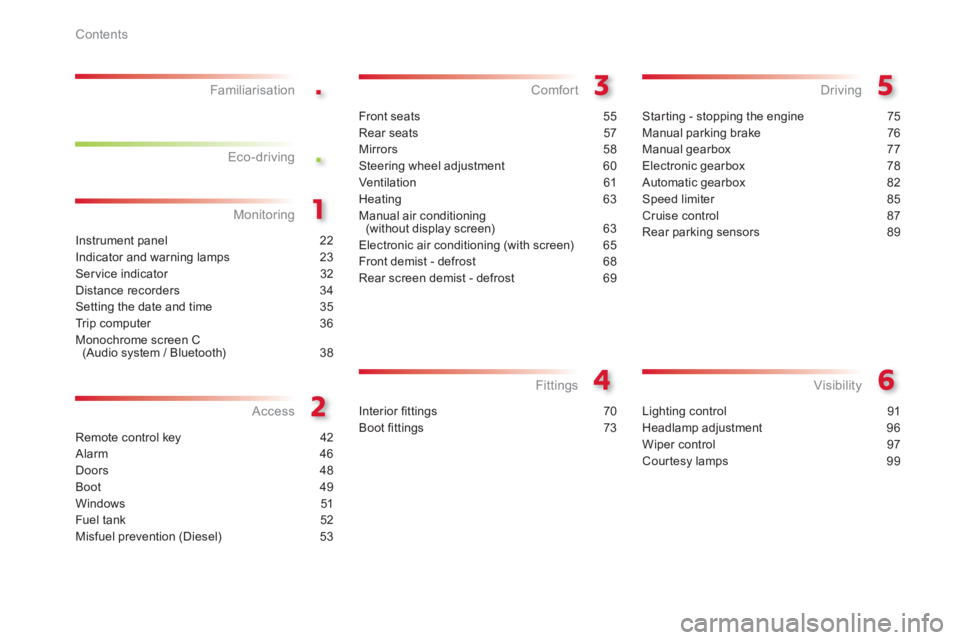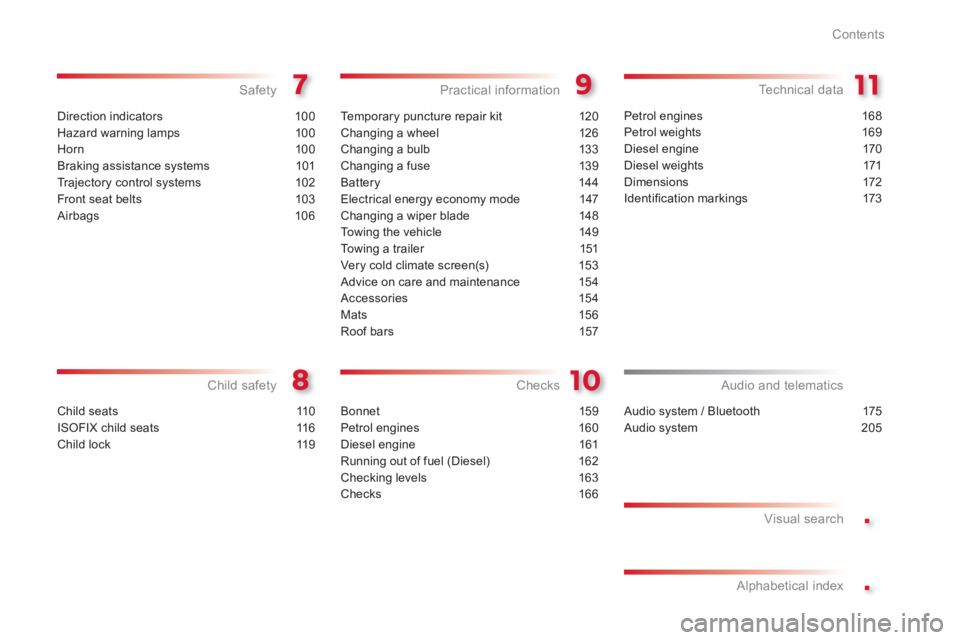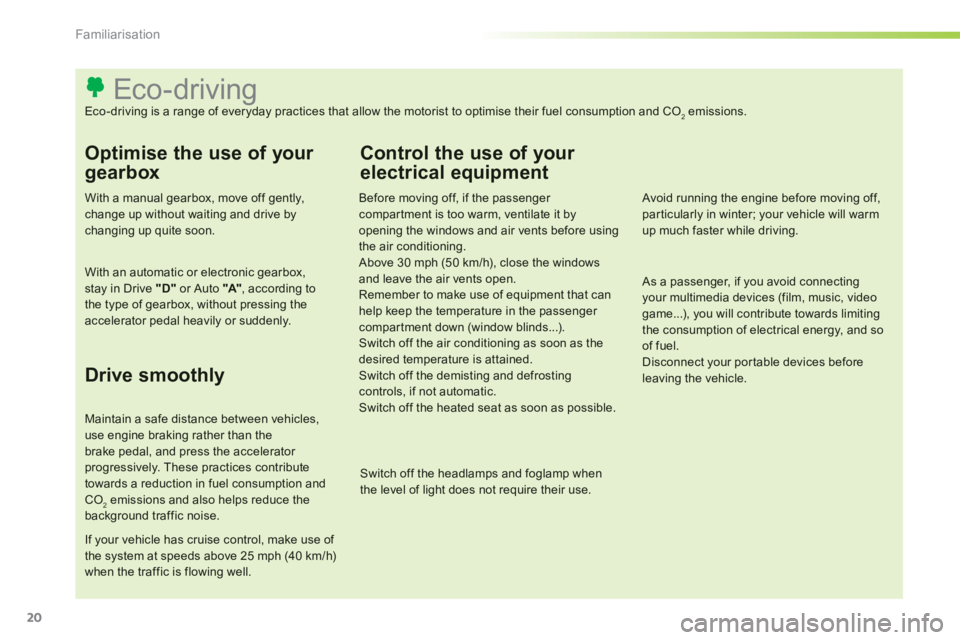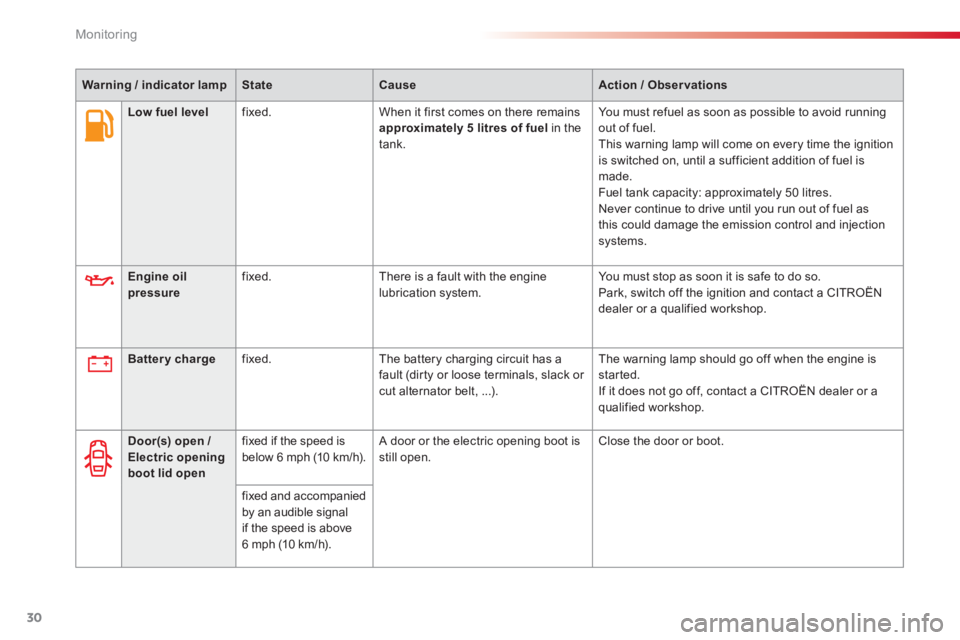fuel CITROEN C-ELYSÉE 2012 Owners Manual
[x] Cancel search | Manufacturer: CITROEN, Model Year: 2012, Model line: C-ELYSÉE, Model: CITROEN C-ELYSÉE 2012Pages: 236, PDF Size: 5.92 MB
Page 4 of 236

.
.
Contents
Instrument panel 22
Indicator and warning lamps 23
Ser vice indicator 32
Distance recorders 34
Setting the date and time 35
Tr i p c o m p u t e r 36
Monochrome screen C(Audio system / Bluetooth) 38
Monitoring Familiarisation
Remote control key 42
Alarm 46
Doors 48
Boot 49
Windows 51
Fuel tank 52
Misfuel prevention (Diesel) 53
Access
Front seats 55
Rear seats 57
Mirrors 58
Steering wheel adjustment 60
Ventilation 61
Heating 63
Manual air conditioning(without display screen) 63
Electronic air conditioning (with screen) 65
Front demist - defrost 68
Rear screen demist - defrost 69
Comfort
Starting - stopping the engine 75
Manual parking brake 76
Manual gearbox 77
Electronic gearbox 78
Automatic gearbox 82
Speed limiter 85
Cruise control 87
Rear parking sensors 89
Driving
Lighting control 91
Headlamp adjustment 96
Wiper control 97
Courtesy lamps 99
Visibility Eco-driving
Interior fi ttings 70
Boot fi ttings 73
Fittings
Page 5 of 236

.
.
Contents
Direction indicators 100
Hazard warning lamps 100
Horn 100
Braking assistance systems 101
Tr ajectory control systems 102
Front seat belts 103
Airbags 106
Safety
Child seats 110
ISOFIX child seats 116
Child lock 119
Child safety
Te m p o r a ry puncture repair kit 120
Changing a wheel 126
Changing a bulb 133
Changing a fuse 139
Battery 144
Electrical energy economy mode 147
Changing a wiper blade 148
To w i ng the vehicle 149
To w i ng a trailer 151
Very cold climate screen(s) 153
Advice on care and maintenance 154
Accessories 154
Mats 156
Roof bars 157
Practical information
Petrol engines 168
Petrol weights 169
Diesel engine 170
Diesel weights 171
Dimensions 172
Identifi cation markings 173
Technical data
Audio system / Bluetooth 175
Audio system 205
Audio and telematics
Visual search
Alphabetical index Checks
Bonnet 159
Petrol engines 160
Diesel engine 161
Running out of fuel (Diesel) 162
Checking levels 163
Checks 166
Page 8 of 236

6
Familiarisation
Fuel t ank
1. Opening the fuel filler flap.2.
Removing the fuel filler cap.
52
Access
Bonnet
159
A.Interior release lever. B.Exterior safety catch
C.Bonnet stay.
3.
Hooking the fuel filler cap.
Ta n k c a p a c i ty: approximately 50 litres.
Page 10 of 236

8
Familiarisation
Instruments and controls
1.
Cruise control / speed limiter controls. 2.
Steering wheel adjustment control.3.
Lighting and direction indicator stalk
H
orn * . 4.
Instrument panel. 5.
Driver's airbag and horn *
.
6.Cigarette lighter / 12 V accessory socket.
USB por t / auxiliary socket.
7. Heated seat control. 8.Fuel filler flap release.
Boot lid release lever * .9.
Bonnet release. 10.Fusebox.11.
Headlamp height adjustment. 12 .Dynamic Stability Control (ESP/ASR)button
Boot lid release button * .
Alarm warning lamp. 13.Door mirror adjustment control. 14.Side adjustable and air vent. 15. Front door glass demisting/defrosting vent.
*
Dependin
g on version.
Page 17 of 236

.
15
Familiarisation
Monitoring
A.With the ignition on, the bars representingthe fuel level should come on. B.With the engine running, the associated
low level warning lamp should go off.
Instrument panel
With the ignition on, the orange and red warning lamps come on.
With the engine running, these warning lamps
should go off.
If a warning lamp remains on, refer to the pageconcerned.
Warning lamps
23-3122
Illumination of the lamp indicates the status of
the corresponding function.
Switch panel
102
A.Deactivation of the ESP/ASR system.
49
B.Opening the boot (depending on version).
C.Alarm warning lamp.
46
Page 22 of 236

20
Familiarisation
Eco-driving
Eco-driving is a range of everyday practices that allow the motorist to optimise their fuel consumption and CO2emissions.
Optimise the use of your
gearbox
With a manual gearbox, move off gently,change up without waiting and drive by changing up quite soon.
With an automatic or electronic gearbox, stay in Drive "D"or Auto "A"
, according to the type of gearbox, without pressing theaccelerator pedal heavily or suddenly.
Drive smoothly
Maintain a safe distance between vehicles, use engine braking rather than the brake pedal, and press the accelerator progressively. These practices contribute towards a reduction in fuel consumption and CO2 emissions and also helps reduce the background traffic noise.
If your vehicle has cruise control, make use of the system at speeds above 25 mph (40 km/h) when the traffic is flowing well.
Control the use of your
electrical equipment
Before moving off, if the passenger compartment is too warm, ventilate it byopening the windows and air vents before using the air conditioning.
Above 30 mph (50 km/h), close the windows and leave the air vents open.
Remember to make use of equipment that canhelp keep the temperature in the passenger compartment down (window blinds...).
Switch off the air conditioning as soon as the desired temperature is attained.
Switch off the demisting and defrostingcontrols, if not automatic. Switch off the heated seat as soon as possible.
Switch off the headlamps and foglamp whenthe level of light does not require their use.
Avoid running the engine before moving off,particularly in winter; your vehicle will warmup much faster while driving.
As a passenger, if you avoid connecting your multimedia devices (film, music, videogame...), you will contribute towards limitingthe consumption of electrical energy, and soof fuel.
Disconnect your por table devices beforeleaving the vehicle.
Page 23 of 236

.
21
Familiarisation
Limit the causes of excess
consumption
Spread loads throughout the vehicle; placethe heaviest items in the bottom of the boot,as close as possible to the rear seats.Limit the loads carried in the vehicle and reduce wind resistance (roof bars, roof rack, bicycle carrier, trailer...). Use a roof box inpreference.Remove roof bars and roof racks after use.
At the end of winter, remove snow tyres and refit your summer tyres.
Observe the recommendations
on maintenance
Check the tyre pressures regularly, when cold, referring to the label in the door aper ture, driver's side.Carry out this check in par ticular:- before a long journey,- at each change of season,- after a long period out of use. Don't forget the spare wheel and the tyres onany trailer or caravan.
Have your vehicle ser viced regularly (engine oil, oil filter, air filter...) and obser ve the
schedule of operations recommended by themanufacturer.
When refuelling, do not continue after the3 rd
cut-off of the nozzle to avoid any over flow.
At the wheel of your new vehicle, it is only after the first 1 800 miles (3 000 kilometres) that you will see the fuel consumption settledown to a consistent average.
Page 24 of 236

22
Monitoring
Instrument panel for petrol - Diesel
1.
Rev counter (x 1 000 rpm). 2.
Screen. 3.Speedometer (km/h).
A.Electronic or automatic gearbox
information.B.Time.C.Range (km) or
Tr i p d i s t a n c e r e c o r d e r.
D. Fuel gauge.E.
Ser vice indicator (km) then,
total distance recorder.
These two
functions are displayedsuccessively when switching on the ignitionF.Speed limiter or cruise control settings.
4.Reminder of service information
Reset the selected function to zero (trip
distance recorder or ser vice indicator)
Adjust the time.
Dials
Screen
Page 32 of 236

30
Monitoring
Warning / indicator lampStateCauseAction / Observations
Engine oilpressurefixed. There is a fault with the engine
lubrication system. You must stop as soon it is safe to do so.
Park, switch off the ignition and contact a CITROËN
dealer or a qualified workshop.
Battery chargefixed.The battery charging circuit has a fault (dirty or loose terminals, slack or cut alternator belt, ...). The warnin
g lamp should go off when the engine is started.
If it does not go off, contact a CITROËN dealer or a qualified workshop.
Door(s) open / Electric opening boot lid open
fixed if the speed is
below 6 mph (10 km/h). A door or the electric opening boot is still open. Close the door or boot.
fixed and accompanied
b
y an audible signal
if the speed is above6 mph (10 km/h).
Low fuel levelfixed.When it first comes on there remainsapproximately 5 litres offfuelin thetank.You must re
fuel as soon as possible to avoid runningout of fuel.This warning lamp will come on every time the ignition
is switched on, until a su
fficient addition of fuel is made.
Fuel tank capacity: approximately 50 litres.
Never continue to drive until you run out of fuel as
this could damage the emission control and injectionsystems.
Page 38 of 236

36
Monitoring
Zero reset
�)Press the control for more than
two seconds to reset to zero the distance
travelled, the average fuel consumption and the average speed.
System that gives you information on the journey in progress (range, fuel consumption…).
Tr i p c o m p u t e r
Screen in instrument panel
Monochrome screen C
Information displays
�)
Press the button, located at the end of the wiper stalk
, to display the various items of
trip computer information in succession.
The trip computer provides the following
information:
-
range,
- current fuel consumption,
- distance travelled,
- avera
ge fuel consumption,
- average speed.
�)
The next press then returns you to the
normal display.